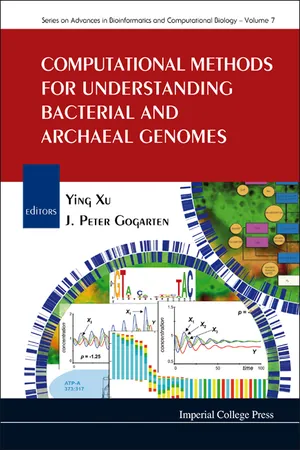
Computational Methods For Understanding Bacterial And Archaeal Genomes
- 496 pages
- English
- PDF
- Available on iOS & Android
Computational Methods For Understanding Bacterial And Archaeal Genomes
About this book
Over 500 prokaryotic genomes have been sequenced to date, and thousands more have been planned for the next few years. While these genomic sequence data provide unprecedented opportunities for biologists to study the world of prokaryotes, they also raise extremely challenging issues such as how to decode the rich information encoded in these genomes. This comprehensive volume includes a collection of cohesively written chapters on prokaryotic genomes, their organization and evolution, the information they encode, and the computational approaches needed to derive such information. A comparative view of bacterial and archaeal genomes, and how information is encoded differently in them, is also presented. Combining theoretical discussions and computational techniques, the book serves as a valuable introductory textbook for graduate-level microbial genomics and informatics courses.
Frequently asked questions
- Essential is ideal for learners and professionals who enjoy exploring a wide range of subjects. Access the Essential Library with 800,000+ trusted titles and best-sellers across business, personal growth, and the humanities. Includes unlimited reading time and Standard Read Aloud voice.
- Complete: Perfect for advanced learners and researchers needing full, unrestricted access. Unlock 1.4M+ books across hundreds of subjects, including academic and specialized titles. The Complete Plan also includes advanced features like Premium Read Aloud and Research Assistant.
Please note we cannot support devices running on iOS 13 and Android 7 or earlier. Learn more about using the app.
Information
Table of contents
- CONTENTS
- Preface
- List of Contributors
- Acknowledgments
- 1. General Characteristics of Prokaryotic Genomes Jan Mr´azek and Anne O. Summers
- 2. Genes in Prokaryotic Genomes and Their Computational Prediction Rajeev K. Azad
- 3. Evolution of the Genetic Code: Computational Methods and Inferences Greg Fournier
- 4. Dynamics of Prokaryotic Genome Evolution Pascal Lapierre
- 5. Mobile Genetic Elements and Their Prediction Morgan G.I. Langille, Fengfeng Zhou, Amber Fedynak, William W.L. Hsiao, Ying Xu and Fiona S.L. Brinkman
- 6. Horizontal Gene Transfer: Its Detection and Role in Microbial Evolution J. Peter Gogarten and Olga Zhaxybayeva
- 7. Genome Reduction During Prokaryotic Evolution Francisco J. Silva and Amparo Latorre
- 8. Comparative Mechanisms for Transcription and Regulatory Signals in Archaea and Bacteria Agustino Mart´ınez-Antonio and Julio Collado-Vides
- 9. Computational Techniques for Orthologous Gene Prediction in Prokaryotes Maria Poptsova
- 10. Computational Elucidation of Operons and Uber-operons Phuongan Dam, Fenglou Mao, Dongsheng Che, Ping Wan, Thao Tran, Guojun Li and Ying Xu
- 11. Prediction of Regulons Through Comparative Genome Analyses Zhengchang Su, Guojun Li and Ying Xu
- 12. Prediction of Biological Pathways Through Data Mining and Information Fusion Fenglou Mao, Phuongan Dam, Hongwei Wu, I-Chun Chou, Eberhard Voit and Ying Xu
- 13. Microbial Pathway Models Siren R. Veflingstad, Phuongan Dam, Ying Xu and Eberhard O. Voit
- 14. Metagenomics Kayo Arima and John Wooley
- References
- Index